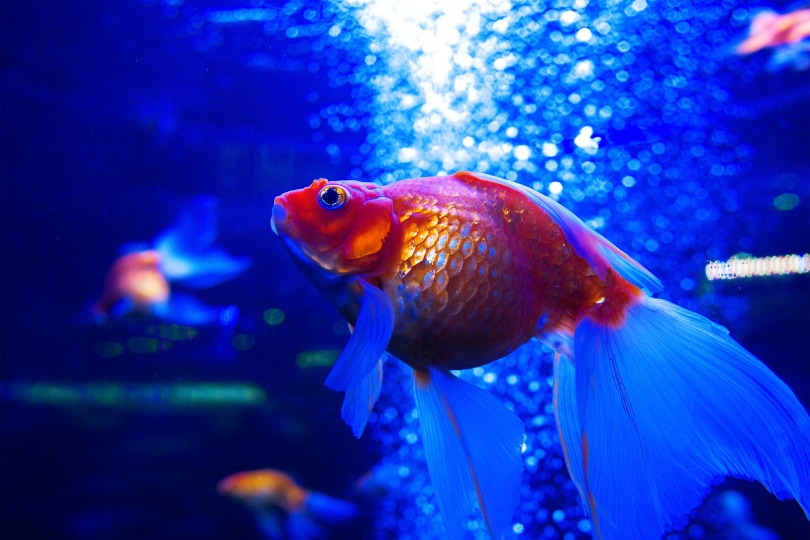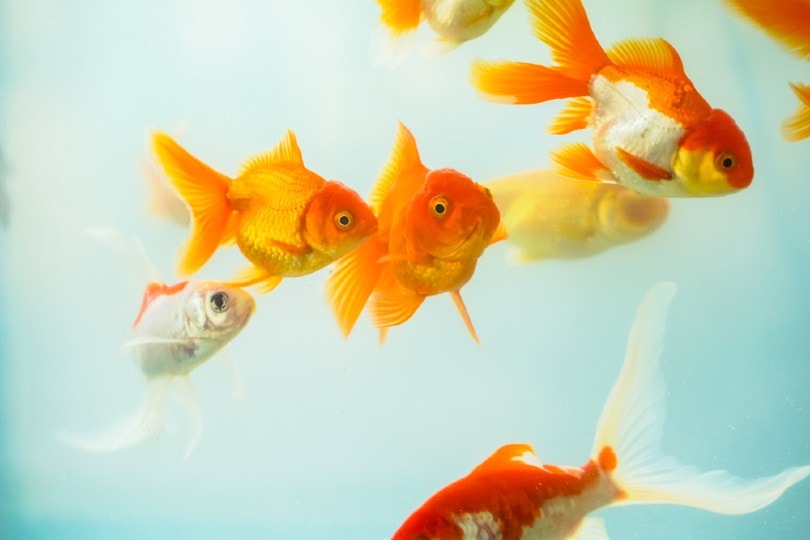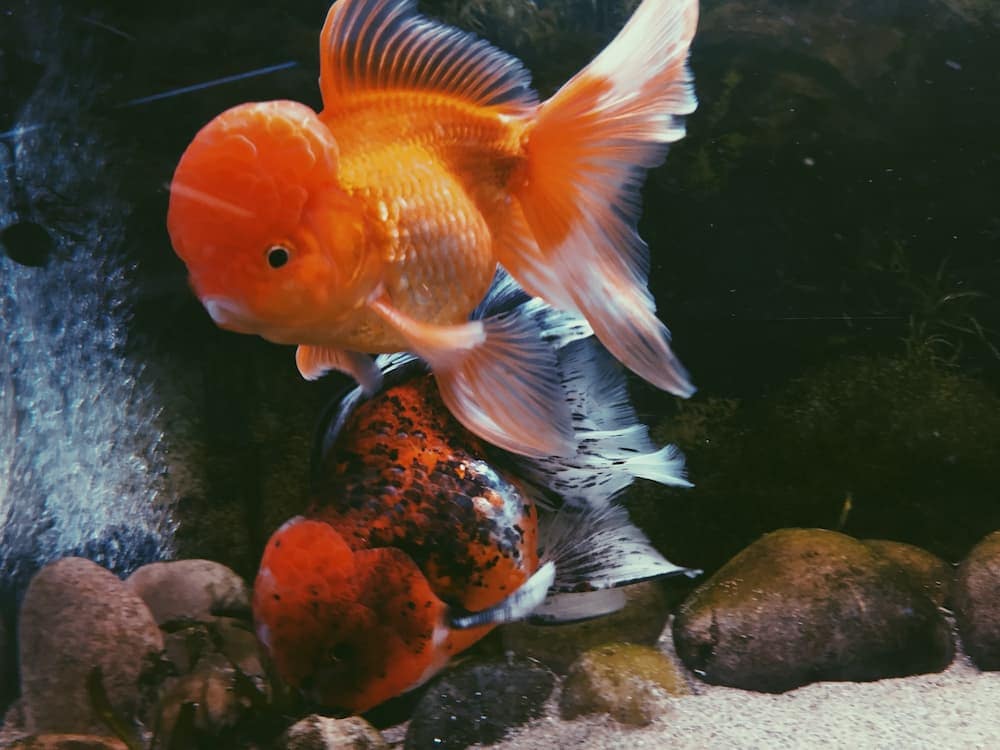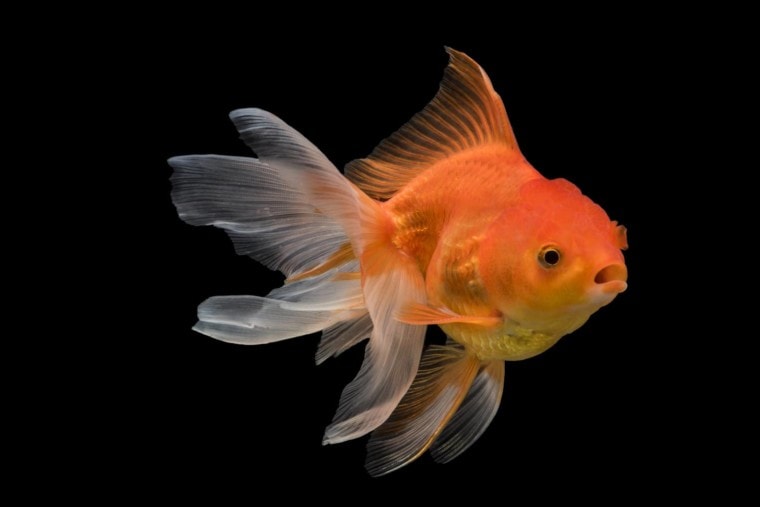
Fantails are a popular type of fancy goldfish that both novice and experienced keepers enjoy caring for. Although they are so easy to acquire, few care aspects should be considered when caring for these beautiful goldfish. Keeping fantail goldfish in their correct conditions will have them thriving for years in your care.
Fantail goldfish are freshwater species that are generally low maintenance, but there are several aspects of their care that is not suitable for first-time hobbyists.
This is a complete guide to help inform you on the fantail goldfish!
Quick Facts About Fantail Goldfish
| Species Name: | Carassius auratus |
| Family: | Cyprinid |
| Care Level: | Beginner |
| Temperature: | 16°C to 24°C |
| Temperament: | Peaceful |
| Color Form: | Various |
| Lifespan: | 5 to 8 years |
| Size: | 6 to 8 inches |
| Diet: | Omnivores |
| Minimum Tank Size: | 20 gallons |
| Tank Set-Up: | Sparsely decorated freshwater tank |
| Compatibility: | Poor |
Fantail Goldfish Overview
Fantails are a simple type of goldfish that is widely available. Fantail goldfish do not have the eye-catching features of some other types of fancy goldfish, which include bubble-eyes, telescope, or dorsal finless goldfish varieties. They are also one of the hardiest species of goldfish and can survive through a lot of beginner mistakes. Fantails can be kept in ponds once they reach over 5 inches in length, but they also thrive in large and filtered tanks.
Fantails are hardy and can live for up to 8 years of age. Although keep in mind fancy goldfish are susceptible to a variety of diseases or disorders from birth. Swim bladder disorder is common in fantail goldfish and is usually the result of one swim bladder being genetically deflated. This makes the second swim bladder work extra hard to keep your fantail goldfish afloat.
Natural populations do not exist in the wild and fantail goldfish are bred across Asia, especially in Japan or China.
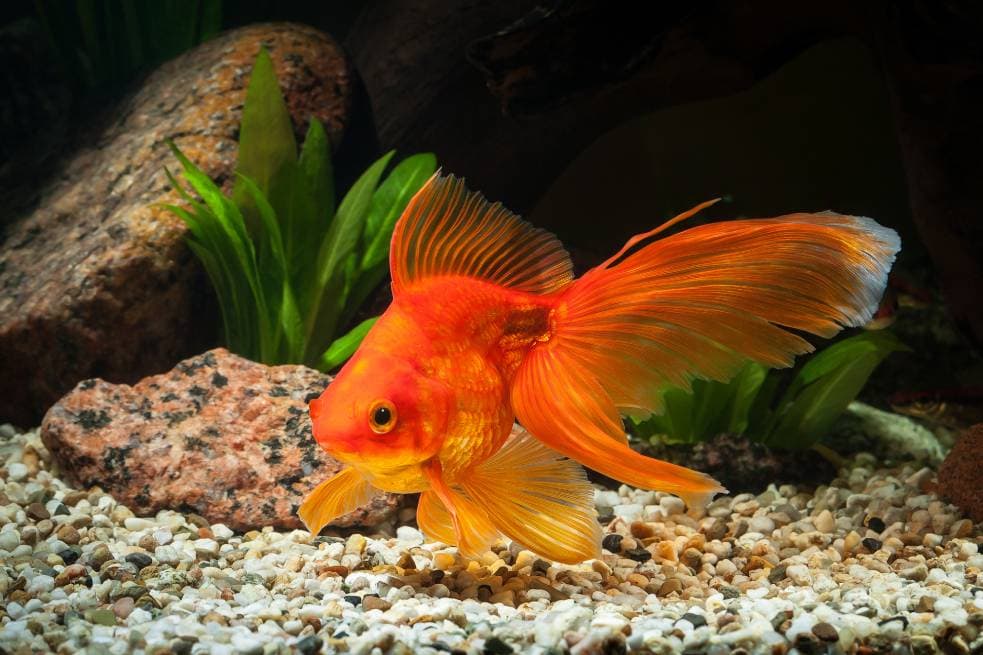
How Much Do Fantail Goldfish Cost?
Fantails are not expensive, but pricing can vary depending on where you get your fantail goldfish from and their type of coloration or pattern. A fantail goldfish can be sold for as little as $5 and as high as $40 for quality specimens. This means stocking your tank with these goldfish should not be overly pricey and a trio will usually never cost more than $60. The larger the fantail goldfish is, the more expensive it will be. If you purchase a fantail goldfish from a professional breeder, they will be sold more due to their good genetic history and sometimes rare colors.
Typical Behavior & Temperament
These goldfish are peaceful and calm species. Fantail goldfish will appreciate other varieties of goldfish as tank mates and they should not be kept alone or in community tanks.
Fantail goldfish will become boisterous and aggressive when kept with other species of fish like tropical or betta fish. They should be kept with other fantails or fancy goldfish to be happy and avoid unwanted behaviors like fin nipping and chasing.
Fantail goldfish will become stressed and lethargic in small tanks and, therefore, require at least a 20 gallon per one and 10 gallons for every additional goldfish.
Appearance & Varieties
Fantail goldfish is described as a basic version of the fancy goldfish. Yet they still have features that separate them from common or comet goldfish. Unlike the sleek body of a single-tailed goldfish, fantails have an egg-shaped body with flowing fins. The fins are long and delicate and are the main attraction when it comes to their physical features. The name fantail goldfish is derived from the tails fanning out in a triangle when viewed from above. The most common colors the fantail goldfish comes in are calico, white, black, orange, yellow, and Japanese-inspired patches.
Calico fantails are especially common and will usually have a button eye. This is an eye that is fully black and has no distinguishable eye features. In some cases, the fantail goldfish can develop minor telescope eyes, but this is uncommon, and breeders can tell from birth which ones are going to have distended eyes.
Fantail goldfish do not usually get over 8 inches, but pond specimens have been known to exceed these lengths.
 How to Take Care of Fantail Goldfish
How to Take Care of Fantail Goldfish
Tank/aquarium size
Fantail goldfish need a large rectangular tank that focuses more on length than height. Fantail goldfish are not ideal for bowls, vases, bio-orbs, or nano set-ups. This is because they grow quite large and need as much space as possible to be healthy. Goldfish are also messy and need a large body of water to dilute the number of toxins and waste they produce. Baby fantails below 1.5 inches in length can be housed in 10 gallons, but they will quickly need to be upgraded. It is generally better to get a large aquarium from the start like a 20-gallon for one and additional gallons added the larger they grow or the more goldfish you add.
As for water temperature and pH, fantails are temperate water fish and prefer temperatures between 61°F to 77°F. Unlike the single-tailed varieties, fantail goldfish do not tolerate cold temperatures well, and a heater should be added to a pond in harsh winter. The pH is flexible but should remain between 7.0 to 8.2.
If you are looking for help to get the water quality just right for your goldfish family in their aquarium, or just want to learn more about goldfish water quality (and more!), we recommend you check out the best-selling book, The Truth About Goldfish, on Amazon today. It covers everything from water conditioners to tank maintenance, and it also gives you full, hard copy access to their essential fishkeeping medicine cabinet!
Related Read: What’s the Ideal Temperature for Goldfish in a Tank or Pond?
Substrate
Sand, fine gravel, and granule substrate are ideal for use in a fancy goldfish tank. Large gravel can get stuck in the fantails mouth and they will choke if it is not released effectively. For this reason, finer substrates are recommended.
Plants
All species of goldfish will uproot and consume live plants, which makes planted tanks unideal for fantails. The decorations should be placed in different areas of the tank to give the goldfish more swim room. Sparse freshwater tanks are best for fantail goldfish.
Lighting
Goldfish are sensitive to bright lights and should rather have a soft orange glow of colored light. Blue and green lights will work for fantail goldfish and will not strain their eyes like harsh white LED lights. Lighting should always come from above and never on the sides as it risks your goldfish looking into it.
Filtration
Fantail goldfish are very messy fish that require strong filtration in the tank. Sometimes, it may be necessary to have more than one type of filter in the tank to keep up with goldfish’s heavy bioload.
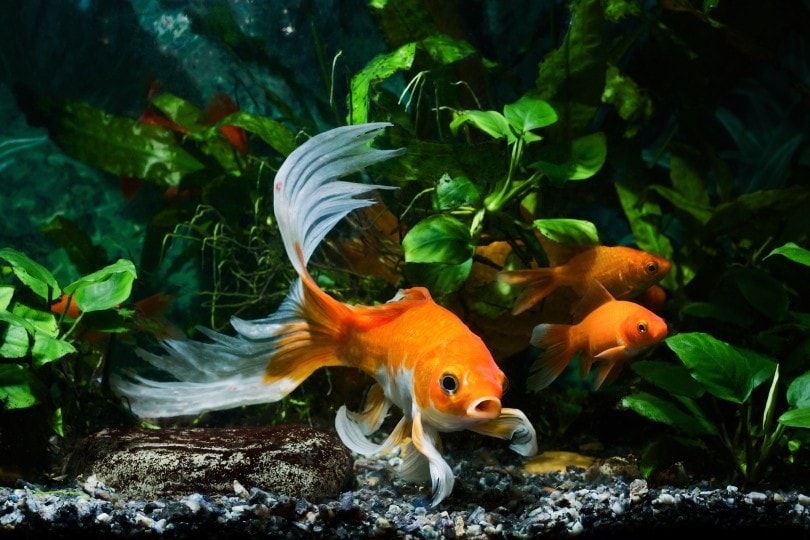
Are Fantail Goldfish Good Tank Mates?
Goldfish in general are poor choices of tank mates and they do not work well with other species of fish. Fantail goldfish should not be kept in a community tank or with other species of fish. Goldfish will eat any fish that fits in their mouth and are at risk of being bullied by other types of large fish. Goldfish tank conditions are unsuitable for many species of fish and the amount of waste goldfish produce will pollute the water column and make it deadly for all the fish inside of the tank. Goldfish should be housed together in pairs or large groups because they are sociable creatures, but this is only applied to be used for goldfish-specific tanks.
Plecos and other sucking mouth fish have been known to suck the slime coat off goldfish which leaves them at risk of being attacked by external parasites. Plecos and corydoras also require tropical temperatures and make poor tank mates.
What to Feed Your Fantail Goldfish
Fantail goldfish should be fed a high-quality pellet. Hikari staple is a good example of a commercial diet for fantail goldfish. Sinking foods are recommended over floating foods, however, fantails with two working swim bladders should have no problem with bouncy. Vegetable matter makes up a large part of their diet and should be incorporated using blanched vegetables like zucchini, romaine lettuce, carrots, and spinach. Fibrous foods help to aid in digestion and will overall keep your fantail goldfish healthy internally.
Fantails require a varied diet that also contains a good number of protein-based supplements. Bloodworms, tubifex worms, daphnia, and mosquito larvae are suitable as protein feed.
Related Read: What Do Goldfish Eat? Different Types of Foods to Offer
Keeping Your Fantail Goldfish Healthy
Fancy goldfish varieties are at risk of developing diseases and parasites, which is why you should quarantine all new fantail goldfish for several weeks. Before placing them in the main tank, fantail goldfish should be treated with a broad-spectrum external medication and dewormed. Deworming fantail goldfish that live in a pond outdoors is essential every three months.
Fantail goldfish that are fed live foods and larvae should be dewormed every two months. If you notice any signs of disease or infections on your fantail goldfish, you should treat them as soon as possible. The earlier treatment starts, the higher the survival rate will be.
Weekly water changes are necessary to lower the number of toxins in the water. The tank should be large and have a good aeration system to oxygenate the water. Never fast fantail goldfish, as this will cause their stomach to shrink to its original size and when they eat a meal again the stomach will painfully and rapidly expand to retain the portion of food. This puts excess stress on their swim bladder organ and can cause a disorder to form.
Breeding
A large and clean tank will encourage your fantail goldfish to spawn. The warmer months will result in more breeding activity, but warm temperatures can also be incorporated using heaters. Protein-rich foods stimulate breeding, and the breeding pair should be fed at least three times a day. Goldfish spawning behavior is distinguished by the male fantail chasing the anus of the female fantail goldfish.
The female deposits hundred of sticky eggs along with the tank and the male fertilizes the eggs with milt. The breeding pair or eggs should be removed immediately because goldfish will eat their eggs and fry.
To make breeding easier, you can use a breeding tank or a spawning net. Spawning nets are easily DIY’d and it will give the fry a place to hide from their parents.
- See Also: Celestial Eye Goldfish
Are Fantail Goldfish Suitable for Your Aquarium?
If you plan to dive into the world of goldfish keeping, you do not want to plan to keep the goldfish in a community tank with other fish. Fantails may be great for beginners but are still not appropriate for bowls, vases, small tanks, and young children. If you have a large, fully cycled tank with a strong filter, then a fantail goldfish will fit right in. Fantail goldfish are also slower and smaller than single-tailed varieties and can be housed indoors more easily.
We hope this article has helped you understand fantail goldfish better!
Featured Image Credit: Waraphornapha, Shutterstock


 How to Take Care of Fantail Goldfish
How to Take Care of Fantail Goldfish
